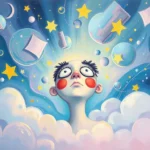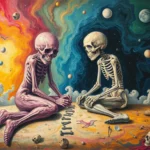
Introduction
Dreams have long fascinated humanity, serving as a bridge between the conscious and subconscious mind. Their enigmatic nature invites interpretation, offering glimpses into our deepest fears, desires, and unresolved conflicts. Why do we dream? This question has captivated psychologists, philosophers, and poets alike throughout history. Dreams can provide insight into our emotional state, highlight unresolved issues in our waking life, and even serve as a canvas for our imagination. Understanding the symbolism within our dreams can unlock profound personal insights and foster self-awareness. In this article, we delve into the intricate world of dream symbolism, exploring its meanings, variations, and connections to our real lives.
Symbolism and Meaning
At the heart of dream interpretation lies symbolism—the use of images, objects, and scenarios that convey deeper meanings. Each dream is unique, reflecting the dreamer’s personal experiences, beliefs, and emotions. However, certain symbols appear frequently across various cultures and contexts, offering common threads for interpretation.
One prevalent dream symbol is flying. This sensation often signifies a desire for freedom or escape from life’s constraints. When flying, one may feel exhilarated, representing a sense of accomplishment or liberation. Conversely, if the flight is accompanied by fear or difficulty, it might indicate anxiety about losing control or facing challenges in waking life.
Another common symbol is water, which can represent emotions and the subconscious. Calm waters might signify emotional stability, while turbulent waves can reflect inner turmoil or unresolved feelings. The depth of the water is also significant; shallow water may suggest superficial emotions, while deep water can indicate profound, perhaps repressed feelings that require exploration.
Animals in dreams carry significant meaning as well. For instance, dreaming of a lion can symbolize bravery and strength, while a snake might represent hidden fears or deceit. The specific characteristics of the animal can further refine the interpretation—an aggressive lion could highlight a struggle with authority, while a gentle deer might signify gentleness and vulnerability.
Additionally, keys in dreams often symbolize access to knowledge, solutions, or new opportunities. A dream involving keys could suggest that the dreamer is on the verge of unlocking a new understanding or a critical solution to a problem faced in waking life.
These symbols, while common, can vary in meaning based on the dreamer’s personal context. Reflecting on your unique circumstances and emotions can help clarify what these symbols signify for you.
Key Scenarios and Variations
Dream scenarios can significantly alter the interpretation of common symbols. For instance, a dream of being chased can evoke feelings of anxiety and fear. The pursuer might represent an aspect of yourself or a situation you are trying to avoid. If you are running in the dream but feel empowered, it might suggest you are actively confronting your fears. Conversely, if you feel helpless, it could indicate a feeling of being overwhelmed in waking life.
Another variation is the dream of losing teeth. Typically, this scenario reflects feelings of insecurity or a fear of aging and loss. However, if the dreamer is calmly accepting the loss, it may symbolize a transition or the shedding of old aspects of the self. In contrast, if the dream evokes panic, it may indicate a deeper anxiety about one’s self-image or personal power.
Being in a classroom is another scenario rich with symbolism. This setting often represents learning and personal growth. If you dream of being unprepared for a test, it could signify self-doubt or anxiety about performance in waking life. Alternatively, if you are actively participating and engaging, it may reflect a readiness to embrace new challenges and opportunities for growth.
Similarly, dreams of relationships can take on various forms. Dreaming of an ex-partner might signify unresolved feelings or the need for closure. However, if you dream of a current partner, it could reflect your dynamics and emotional connection. The emotional tone of the dream—whether it is filled with joy, tension, or uncertainty—can provide clues to your real-life relationship status.
Even symbols like houses can shift in meaning based on the dream’s context. A well-kept house might symbolize security and stability, while a dilapidated house can reflect feelings of neglect or disarray in one’s life. If rooms in the house are unexplored, they may represent aspects of the self that require attention and exploration.
Ultimately, the interpretation of dreams is deeply personal. The significance of scenarios and the feelings they evoke must be examined in light of the dreamer’s real life. By reflecting on emotional responses and the context of each scenario, individuals can gain a clearer understanding of what their dreams are trying to convey.
Real-Life Connections and Takeaways
Understanding the symbolism and variations of dreams provides a valuable tool for self-reflection. Dreams often mirror our waking lives, revealing hidden emotions and unresolved conflicts. By examining the symbols and scenarios present in your dreams, you can gain insights into your current emotional state and life circumstances.
For instance, if you find yourself frequently dreaming of flying, consider what areas of your life you feel constrained in. Are there situations or relationships that feel limiting? Reflect on what it would mean to embrace a sense of freedom and autonomy. This awareness can empower you to make conscious choices that align more closely with your desires.
If you experience recurrent dreams involving water, take note of your feelings toward it. Are you comfortable swimming in deep waters, or do you feel anxious? This can reflect your relationship with your emotions. If you are struggling with feelings of anxiety, consider exploring these emotions through journaling or therapy. Engaging with your feelings can lead to greater emotional clarity and healing.
Additionally, consider the relationships depicted in your dreams. If an ex-partner frequently appears, reflect on what unresolved feelings or lessons may be emerging. This could be an opportunity for personal growth and closure. On the other hand, if you dream of current relationships, assess how you feel about these connections in your waking life. Are there unresolved issues that need addressing? Open communication with loved ones can often lead to deeper understanding and strengthened bonds.
It’s also beneficial to maintain a dream journal. Recording your dreams immediately upon waking can enhance your ability to recall them and reflect on their meanings over time. Look for patterns or recurring symbols as you document your dreams. This practice can deepen your self-awareness and provide a clearer understanding of your subconscious mind.
As you reflect on your dreams, consider asking yourself questions like: What emotions did I feel during the dream? What was happening in my waking life around the time of the dream? Are there any current challenges or decisions that resonate with the dream’s themes? This inquiry can open doors to deeper self-understanding.
In conclusion, dreams serve as mirrors, reflecting our inner worlds and illuminating paths for personal growth. By understanding the symbolism within your dreams and connecting them to your waking life, you can unlock profound insights that foster self-discovery and emotional healing. Embrace your dreams as a powerful tool for understanding and navigating the complexities of your life. Take time to pause, reflect, and explore the secrets that lie within your dreams, for they may just hold the keys to your personal transformation.







